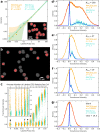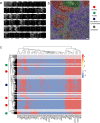MACSima imaging cyclic staining (MICS) technology reveals combinatorial target pairs for CAR T cell treatment of solid tumors
- PMID: 35115587
- PMCID: PMC8813936
- DOI: 10.1038/s41598-022-05841-4
MACSima imaging cyclic staining (MICS) technology reveals combinatorial target pairs for CAR T cell treatment of solid tumors
Abstract
Many critical advances in research utilize techniques that combine high-resolution with high-content characterization at the single cell level. We introduce the MICS (MACSima Imaging Cyclic Staining) technology, which enables the immunofluorescent imaging of hundreds of protein targets across a single specimen at subcellular resolution. MICS is based on cycles of staining, imaging, and erasure, using photobleaching of fluorescent labels of recombinant antibodies (REAfinity Antibodies), or release of antibodies (REAlease Antibodies) or their labels (REAdye_lease Antibodies). Multimarker analysis can identify potential targets for immune therapy against solid tumors. With MICS we analysed human glioblastoma, ovarian and pancreatic carcinoma, and 16 healthy tissues, identifying the pair EPCAM/THY1 as a potential target for chimeric antigen receptor (CAR) T cell therapy for ovarian carcinoma. Using an Adapter CAR T cell approach, we show selective killing of cells only if both markers are expressed. MICS represents a new high-content microscopy methodology widely applicable for personalized medicine.
© 2022. The Author(s).
Conflict of interest statement
A.K., C.H., P.P., J.P., D.Y., S.R., S.Re., F.C.R., D.S., J.K., V.D., M.M.O., L.M., C.R., A.D., T.D.R., S.B., M.B., J.K., M.J., D.E., O.H., C.D., E.S., R.P.P., S.M., J.S., W.M., A.B. are or were employees of Miltenyi Biotec B.V. & Co., E.S. is an employee of Miltenyi Imaging GmbH and M.N. is an employee of Qi Biotech, Inc. There are patent applications pending related to this work.
Figures







References
MeSH terms
Substances
LinkOut - more resources
Full Text Sources
Other Literature Sources
Medical
Miscellaneous

